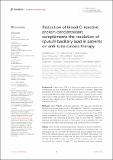Reduction of blood C-reactive protein concentration complements the resolution of sputum bacillary load in patients on anti-tuberculosis therapy
Abstract
Background : Tuberculosis (TB) is a difficult-to-treat disease requiring the combination of four antibiotics for a minimum of 6 months. Rapid and quantitative biomarkers to monitor treatment response are urgently needed for individual patient management and clinical trials. C-reactive protein (CRP) is often used clinically as a rapid marker of inflammation caused by infection. We assessed the relationship of TB bacillary load and CRP as biomarkers of treatment response. Methods : Xpert MTB/RIF-confirmed pulmonary TB cases were enrolled for treatment response assessment in Mozambique. Treatment response was measured using the Tuberculosis Molecular Bacterial Load Assay (TB-MBLA) in comparison with standard-of-care Mycobacterium Growth Indicator Tube (MGIT) culture at baseline and at weeks 1, 2, 4, 8, 12, 17, and 26 of treatment. Blood CRP concentration was measured at baseline, week 8, and week 26. Treatment response was defined as increase in MGIT culture time to positivity (TTP), and reduction in TB-MBLA-measured bacillary load and blood CRP concentration. Results : Out of the 81 screened presumptive TB cases, 69 were enrolled for 6-month treatment follow-up resulting in 94% treatment completion rate. Four participants did not complete TB treatment and 22 participants had missing CRP or TB-MBLA results and were excluded from TB-MBLA-CRP analysis. The remaining 43 participants-median age, 31 years old [interquartile range (IQR): 18-56]; 70% (30/43) male; and 70% (30/43) infected with HIV-were considered for analysis. Culture TTP and bacillary load were inversely correlated, Spearman's r = -0.67, p < 0.0001. Resolution of sputum bacillary load concurred with reduction of blood CRP, r = 0.70, p < 0.0001. At baseline, bacillary load had a median (IQR) of 6.4 (5.5-7.2), which reduced to 2.4 (0.0-2.9) and 0.0 (0.0-0.0) log10 CFU/ml at months 2 and 6 of treatment, respectively. Correspondingly, blood CRP reduced from 1.9 (1.6-2.1) at baseline to 1.3 (0.9-1.7) and 0.4 (0.1-0.8) log10 mg/dl at months 2 and 6 of treatment, respectively. CRP reduction trialed bacteriological resolution at a rate of -0.06 log10 mg/dl compared to a bacillary load of 0.23 log10 CFU/ml per week. Consequently, 14 (33%) and 37 (88%) patients had reduced CRP to normal concentration and bacillary load to zero by the end of treatment, respectively. Pre-treatment CRP concentration and bacillary load, and resolution during treatment were slightly lower in HIV co-infected patients but not significantly different from HIV-uninfected TB patients. Conclusion : TB-MBLA-measured bacillary load and blood CRP complement each other in response to anti-TB therapy. Slow CRP reduction probably reflects residual TB bacilli in the lung not expectorated in sputum. Combining both measures can improve the accuracy of these biomarkers for monitoring TB treatment response and shorten turnaround time since the results of both assays could be available in 24 h.
Citation
Azam , K , Khosa , C , Viegas , S , Massango , I , Batt , N , Jani , I , Heinrich , N , Hoelscher , M , Gillespie , S H , Rachow , A & Sabiiti , W 2022 , ' Reduction of blood C-reactive protein concentration complements the resolution of sputum bacillary load in patients on anti-tuberculosis therapy ' , Frontiers in Immunology , vol. 13 , 1005692 . https://doi.org/10.3389/fimmu.2022.1005692
Publication
Frontiers in Immunology
Status
Peer reviewed
ISSN
1664-3224Type
Journal article
Description
Funding: This study was conducted under the PanACEA Biomarkers Expansion (PanBIOME) programme and the establishment of Maputo Tuberculosis Trial Unit (MaTuTU Project) which was funded in parts through the European and Developing Countries Clinical Trials Partnership (EDCTP), PZA-study and Federal Ministry of Education and Research (BMBF), Germany.Collections
Items in the St Andrews Research Repository are protected by copyright, with all rights reserved, unless otherwise indicated.

